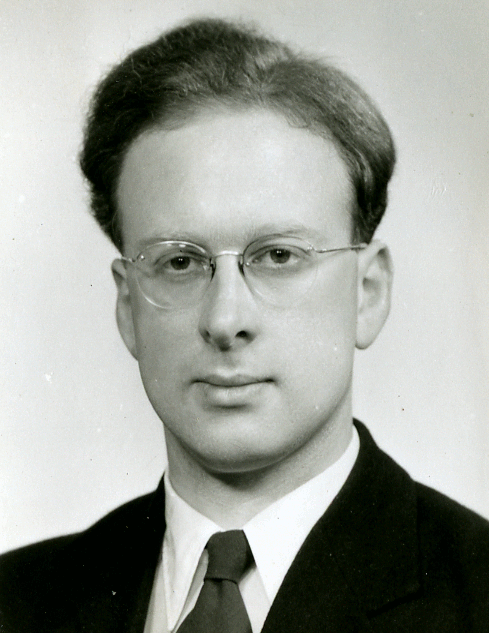First of all, I am the world’s worst science historian, so don’t take this as a reputable history article. Second, the field will sort out the historical credit, so I am not concerned with that. Here is a picture of the young Peter Higgs, who worked on the Higgs Boson around 1964, but the picture is from 1954
What the press has not noted about the name Higgs Boson, is that it contains the name of two physicists. The Higgs Boson is a spin 0 particle. The fact is that spin 0, spin 1, spin 2, and other integer spin particles are named Bosons after the Indian physicist from Calcutta, named Satyendra Nath Bose, or often S. N. Bose. He wrote his paper on the identical treatment of these particles, of which the spin 1 photon is the most important example, in 1924. He sent it to Einstein to translate into German, who submitted it for him for publication. Of course, Wikipedia has an excellent article on him. He did not receive a Nobel Prize for his discovery. Paul Dirac named such integer spin particles Bosons. So the naming of the particle the Higgs Boson, also pays great honor to S. N. Bose. Here is his picture, dated in 1925:
The musing is about what the Higgs field has been named when discovered on other planets, or might be called in the future. Since it has the role of providing mass to the quarks, leptons, and other bosons except for the photon, I would think that the field might just be called the “mass field”, or “vacuum field”, or “aether”. The new particle or excitation of the field, might be called “mass particle”. It could also be called “the ultimate scalar”, where scalar means a spin 0 particle. Only in a secular society could it be nick-named “The God Particle” as a supposed joke by Leon Lederman. Yet, it is everywhere in space and time, and is always interacting with all particles, except not photons, and maybe not neutrinos.
Just as in the rest of language, the younger generation creates the new additions to the Physics language, with new concepts, or new interpretations of older concepts. Historical names often get replaced. The combined theory of electromagnetic and weak interactions that uses the Higgs field was created by Steven Weinberg and Abdus Salam. It was initially called Weinberg-Salam theory. Now it is more often called Electroweak Theory. Murray Gell-Mann and George Zweig developed the theory of “colored” quarks bound by gluons into mesons and nucleons, and that is now called QCD, or Quantum Chromodynamics, a mouthful. The quarks were not named for Gell-Mann, since he chose the name “quark” after its sound and its occurrence in a triad in Finnigan’s Wake, since there are three colors.
The spin 1/2 particles like the electron, proton, and neutron that make up our everyday universe are called “fermions” after Enrico Fermi. To my knowledge, the spin half nature of them really emerged in solutions to the relativistic, quantum mechanical equation derived by Paul A. M. Dirac. The exclusive statistics is called Fermi-Dirac statistics. This is better known to chemistry students as the Pauli Exclusion Principle after Wolfgang Pauli.
In 2010, the J. J. Sakurai Prize for Theoretical Physics, from the American Physical Society, was awarded to the six physicists who worked on the Higgs theory. Besides Peter Higgs, who is not in this photo, there are from our left to right: T. W. B. Kibble, Gerald S. Guralnik, Carl R. Hagen, Francois Englert, , Robert Brout. Kibble, Hagen and Guralnik worked together, and Englert and Brout worked together.
Of course credit for the discovery of the Higgs particle has to be given to the physicists who built the LHC (Large Hadron Collider) at CERN, to the 3,000 physicists at each of the ATLAS and CMS detectors, and to the many nations which funded this project.



